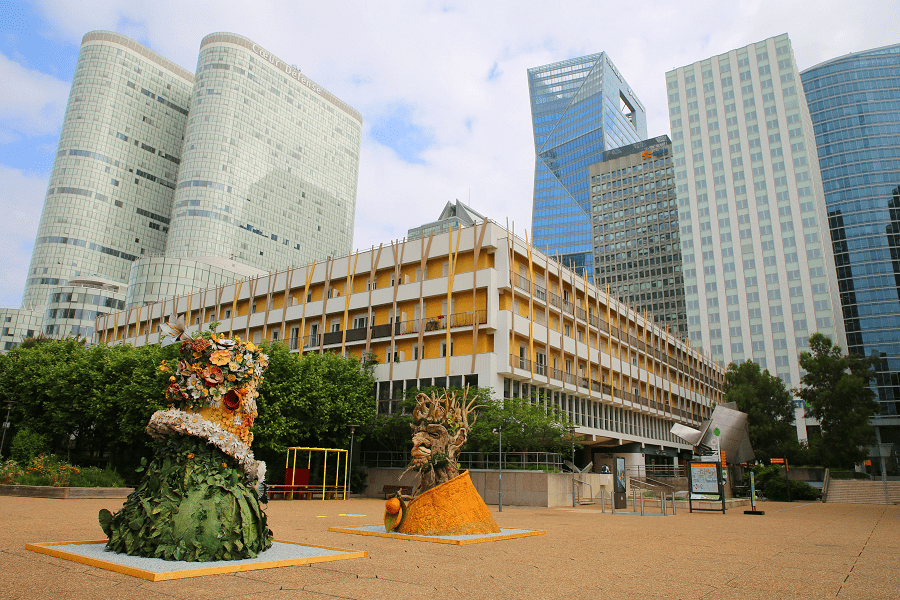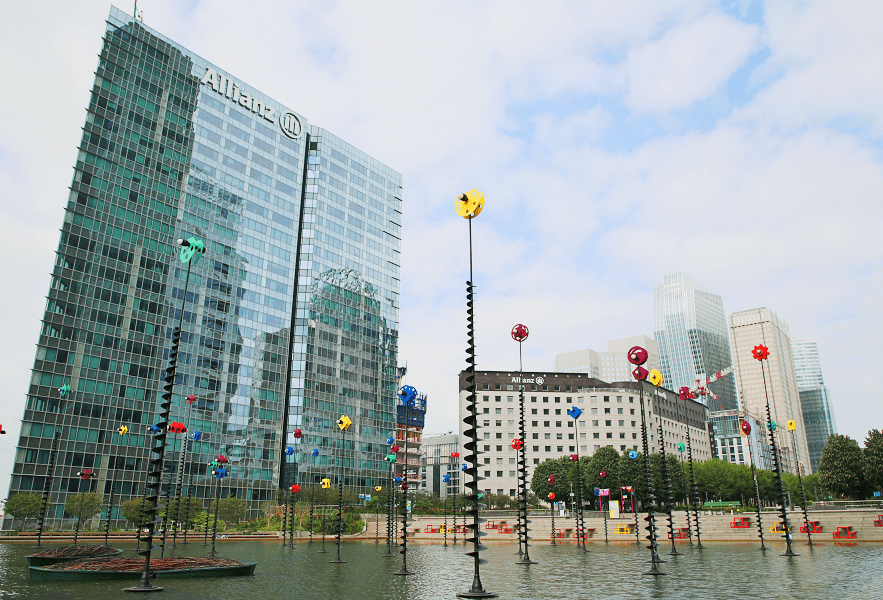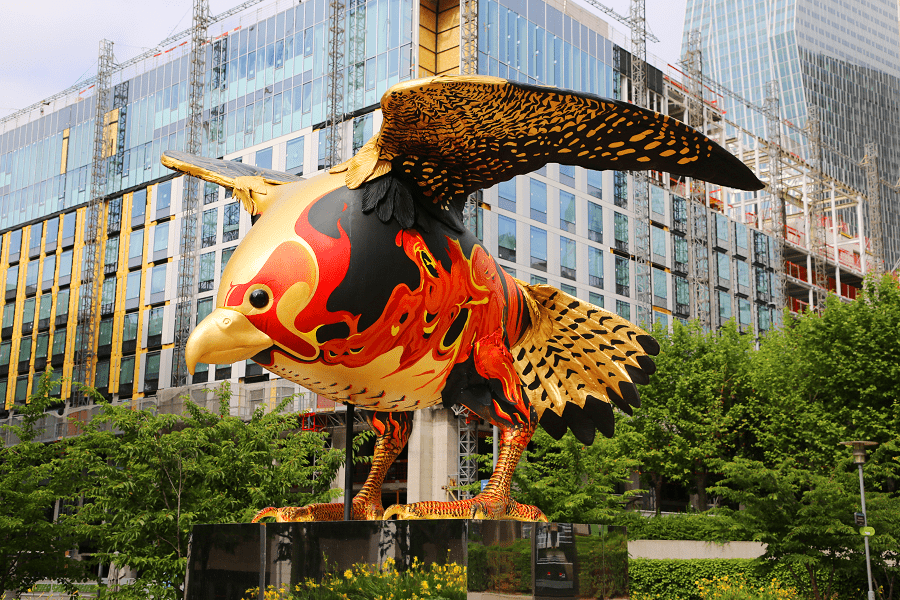La Défense is a business district located in the Greater Paris metropolis in Île-de-France, the second most attractive business district in Europe, after the City of London, and 4th in the world. The district is notably home to the headquarters of many French and foreign companies as well as the European banking authority.
It is located in the northwest suburbs of Paris (France), in the department of Hauts-de-Seine, on the territories of the communes of Puteaux, Courbevoie, Nanterre and La Garenne-Colombes, at the western end of the historic axis which begins at the Louvre Palace and continues along the Avenue des Champs-Élysées, the Arc de Triomphe de l’Étoile and beyond to the Pont de Neuilly and the Arche de la Défense.
La Défense is named after the statue La Défense de Paris by Louis-Ernest Barrias, which was erected in 1883 to commemorate the soldiers who had defended Paris during the Franco-Prussian War.
Built since the 1960s, La Défense is mainly made up of high-rise buildings, mainly comprising offices (around 3 mln sq. m). La Défense is, however, a mixed district: it accommodates 600,000 m2 of housing and the opening of the Les Quatre Temps shopping center in 1981 made it a major commercial hub in Île-de-France. In 2009, the district had 2,500 businesses, around 180,000 employees and 20,000 residents spread across 71 towers. It notably houses the headquarters of large French and foreign multinationals.
The neighborhood stretches in and out of a one-way circular boulevard. It extends over 160 hectares and was divided in 2011 into four large sectors (Arche Nord, Arche Sud, Esplanade Nord and Esplanade Sud) which replace the twelve former numbered sectors.
The district extends over a vast pedestrian slab of 31 hectares raised above the natural ground. The public space of the slab, essentially mineral, is also made up of hanging gardens and ponds. On the slab, around sixty works of art make La Défense an open-air museum.
La Défense is not an isolated business center, but is located in a vast area of western Paris where tertiary activity is particularly powerful.
The development of the La Défense district was entrusted by the State in 1958 to the public establishment for the development of the La Défense region (EPAD), whose scope of intervention was reduced in 2000, then expanded in 2010, becoming the Public Development Establishment of La Défense Seine Arche (EPADESA) in order to implement a coherent project “from the Seine to the Seine”, in one of the major territories of Greater Paris.
The scope of action of this entity created in 2010 goes far beyond the circular boulevard of La Défense and now extends to the municipalities of Puteaux, Courbevoie, Nanterre and La Garenne-Colombes.
The territory is classified as an “operation of national interest”, which places planning authorizations under the responsibility of the State and not the mayors. Since 2009, the business district has been managed by Defacto, which maintains public spaces and ensures the promotion and animation of Defense (mission previously led by EPAD).
In May 2016, the constitution on January 1 of a new local public establishment intended to replace EPADESA and Defacto was announced by Matignon, transferring to local authorities the steering and financing of the management and development of the area.
The creation of the Paris La Défense public establishment finally took place on January 1, 2018.
Main sights
The best-known buildings today are the Grande Arche and the CNIT. Other towers are emblematic of the various eras of development of the district: Initiale and Europe towers for the first generation, CB21 and Areva for the second generation, Total for the third.
For the fourth generation, the Phare and Signal towers (winning project by Jean Nouvel) were to be part of it. The Signal Tower was thus presented by EPAD as the culmination of the renewal plan. These projects, undermined by the 2008 financial crisis and financing difficulties, were however delayed, then canceled. The Link, Sisters, Hekla, Jardins de l’Arche and Odyssey tower projects should probably, if they are built, become the new symbols of the business district.
Open-air museum
Besides the representative architecture, the area also houses an open-air museum with 70 statues and pieces of modern art, including the following works:
César, Thumb (1965)
Joan Miró, Two fantastic characters (1976)
Alexander Calder, Red Spider (1976)
Yaacov Agam, Fountain (1977)
Richard Serra, Slat (1982)
Shelomo Selinger, The Dance (1983)
Bernar Venet, Two Indeterminate Lines (1988)
Takis, Bright Trees (1990)
Igor Mitoraj, Tindaro (1997)
Emily Young, Four Heads (2002)
Patrick Blanc, Green wall (2006)
Louis-Ernest Barrias, La Défense de Paris (1883)
François Morellet, La Défonce (1990)
Guillaume Bottazzi, Peinture de 216 m² (2014)
Transport
The La Défense district is served by several lines of Paris metro and RER:
La Défense train station and La Défense metro station
- (RER) (A) Transilien Line L of Transilien Line U of Transilien (T) (2)
- (M) (1)
- (BUS) RATP 73 141 144 159 174 178 258 275 276 278 360
- Poissy – Les Mureaux A14 Les Mureaux A14 Verneuil
- Mantois 72 A14B A14M
- Saint-Germain Boucles de Seine A14 Chambourcy
- (BUS) N24
Esplanade de la Défense
- (M) (1)
- (BUS) RATP 73 157 158 174 175 176
- (BUS) N24
Faubourg de l’Arche
- (T) (2)
- (BUS) RATP 73 178
- (BUS) N24
See more:



























